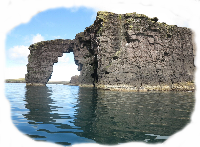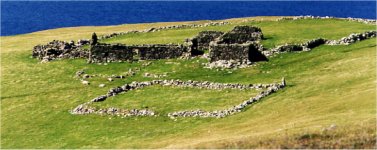

Interest in Shetland's Norse style watermills is ongoing. Although small and slow this mill had millstones that were unique, by being horizontal. They were built over, or near to a burn, when a speld or sluice was used to divert the water into the mill. Sometimes as many as three mills stood in a row and used the force of water to turn the axle or fedders and eventually turn the oversten or upper millstone.
The most important grain milled was 'bere' a type of barley, because it yielded more grain and the resulting meal was baked into bread or used to make gruel or porridge. The other grain grown and milled was oats which although giving less meal did give better fodder for animals. HEARD is at present considering the restoration of a ruined watermill at Tangwick and you can read more about this in the projects section.


The next era was the Scottish period. Thankfully this area was not subjected to castles being built here, however in 1599 Earl Patrick Stewart ordered all labourers, farm workers and servants from Hillswick to appear at his castle in Scalloway after Whitsunday, where they were forced to move stones and timber, make and carry mortar or do any other work demanded by him, without pay for 8 days at a time. They could be made to work for as many eight day stints as Patrick Stewart enforced on them. Besides not being paid they were given no food or drink and from one account of a complaint of cruelty made against the Earl, it declares that the poor men were 'a rakabens, depooperit an fameschit fae lak o veveris' in other words they were starving, overworked wrecks of skin and bone, by the time they got back home. This was a miserable time in the district, as indeed it was in the rest of Shetland, for under Norse rule the islanders lived in peace, they were independent and proud folk and were reasonably well off, being able to afford some valuable bits and pieces. They were also self-confident enough to argue for their rights when the Scots arrived because they were Norwegians and because of their faith in udal law but it was all hopeless.
After the influx of the Scottish Earls, poverty became a common word and the plight of many folk who until then had owned their crofts, found themselves tenants of some laird with taxes not only having to be paid to him, but also to the church minister, who was entitled to teinds or tithes payable by the crofter come fishermen in oil, fish and butter.
The minister also claimed three days of free labour each year, from each adult in his parish. Some ministers used this slavery to have peats cut and brought home to the manse for winter fuel, others tenants were exploited by having to hand dig and plant the Glebe, a superior bit of arable land that was allocated to the minister Certainly the Scottish Lairds were disliked, but the clergy and other favourites of the court, in truth caused more damage to local folk. The minister of Northmavine, James Pitcairn who stayed in the manse at Upper Urafirth amassed an estate worth £3,000, an absolute fortune at that time.
The only buildings or relics from this period are the ruined fishing lodges and trading booths rented to or the ground on which they stood was leased by the landowners to the Dutch and Germans who were trading in this area at the time. The Hanseatic traders then offered to the fishermen or crofters by sale or for barter hooks, lines, a kind of bread called cringel, or ground flour or corn, Rotterdam gin as well as cloth such as muslin, linen or lace and in return the local folk traded salted fish, knitwear, butter and whale or fish liver.
Another sad reminder of this time is the number of ruined crofts dotted around the place. Not all of them are because of the clearances that took place, because in some places Shetland families were actually helped to emigrate or relocated to other areas, unlike the clearances in Scotland, but they did happen here also and prime examples are the Hillswick Ness and Tingon in Eshaness.
Few recent excavations have been done in this area and the ones carried out in the past recorded little information about the buildings or sites, as the main interest seems to have been in finding artefacts. No important treasure has ever been found here - so far - but small important things have been uncovered over the years, among them, the Hillswick Beads, the Cross Kirk Horse, Mace Heads, and Combs as well as toy quern stones, although there are no doubt umpteen boxes of finds, not generally known about, being stored away somewhere in Edinburgh.